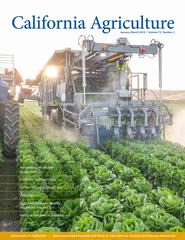All Issues

A romaine lettuce harvester. Photo courtesy of Taylor Farms.
Matteo Garbelotto introduces the California Agriculture issue on phytophthora contamination of ecological restoration sites.
Volume 72, Number 2
News and opinion
Four ways farmers are responding to the tightening labor market.
Briefs of recent AES and UCCE research papers on tree mortality, sugary drinks, mountain runoff and wild bees.





